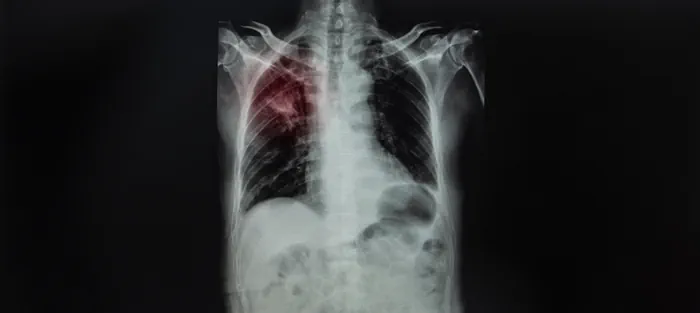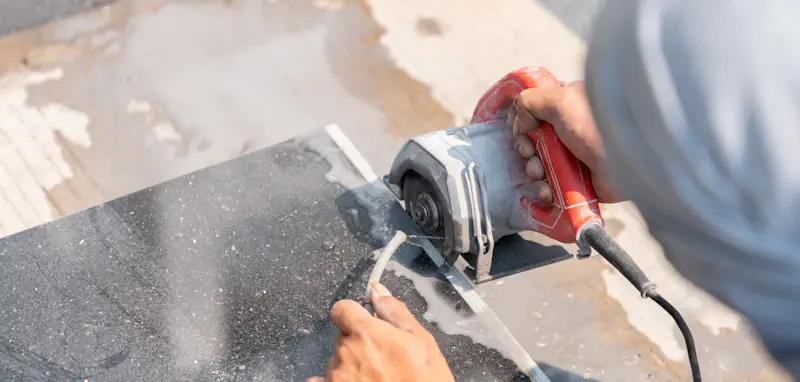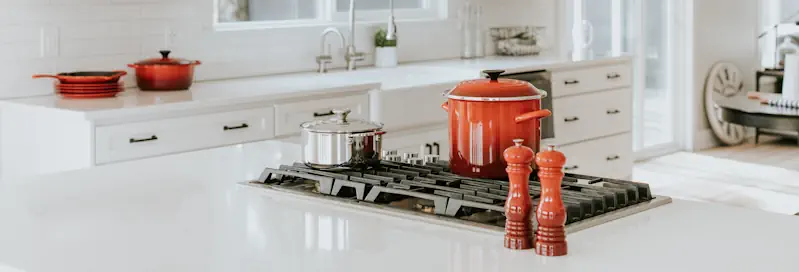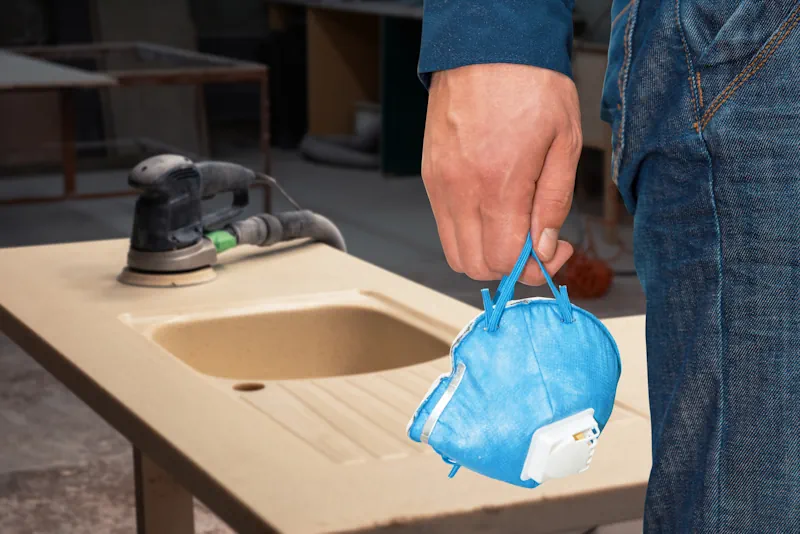Do you know the hidden danger lurking in popular building materials? Engineered stone – an affordable and attractive building material, is linked to silicosis, a severe and debilitating lung disease. In 2023, concern for the health of engineered stone workers is growing along with the material’s demand in Australia. This article addresses the “engineered stone ban” by examining the dangers, laws, and manufactured stone alternatives. Doing this gives consumers and building industry employees some insight into the facts.
Defining Engineered Stone Products
To make engineered stone, natural stone materials are mixed with additional chemical substances like water, resins, or colouring agents, and then subjected to a hardening process. Combining natural stone materials creates a product containing respirable crystalline silica.
Rising Concerns About Engineered Stone and Silicosis
Engineered stone’s popularity as an affordable and attractive material for kitchen and bathroom benchtops has come at a heavy price. Sadly, while building our dream home, we had no idea this widely used material would become a significant health hazard for stone workers. When cut, engineered stone releases fine silica dust, developing silicosis in those breathing the fine particles.
Recognising the risks and differences between engineered and natural stone materials and knowing the health and safety risks while handling these products is essential to protecting Australian workers.
Australia is seeing increased calls for a total ban on engineered stone. Now, more than ever, we must inform ourselves about the possible safety risks of this widely used material for kitchen benchtops panels and slabs.
Note: There are no safety risks when using previously installed engineered stone. Additionally, there is no necessity to replace your benchtops.

About Silicosis
Inhaling silica dust, a component of manufactured stone products, results in the long-term lung disease silicosis. The high levels of silica in engineered stone benchtops increase the risk of silicosis for those working with this material. Consequently, Safe Work Australia recommends an Australia-wide ban.
There are serious consequences for a silicosis diagnosis, including:
- Scarring on the lungs
- Difficulty breathing
- Reduce mobility
- Potentially even organ failure and death
With such severe health and safety risks, it’s not surprising that health and safety ministers (including Workplace Relations Minister Tony Burke) have had discussions about the dangers associated with manufactured stone. This content is highlighted in the Safe Work Australia report.
Engineered Stone vs. Natural Stone Materials
Engineered stone, with up to 97% silica content, poses a much higher risk of silicosis compared to natural stones like:
• Marble (2% silica)
• Granite (around 30% silica)
• Sandstone (70-95% silica)
It’s the manufacturing process, where pulverized quartz is combined with polymers, that results in engineered products having a higher silica content.
Unfortunately, workers are often exposed to dangerous silica dust when cutting, polishing or drilling engineered stone. Inhaling this dust leads to silicosis and other potentially fatal health risks. To reduce exposure to silica dust, employees must adopt safety precautions such as:
- Sufficient ventilation
- Using wet methods while cutting engineered stone benchtops
- Use of appropriate personal protective equipment
- Regular cleaning while doing such work

Actions to Ban Engineered Stone
As health and safety risks become more apparent, we can expect an increased demand to implement a strict engineered stone ban. Advocates like Tristan Wilson, a father of two diagnosed with silicosis after working as a stonemason for five years, are advocating for change. They seek to protect workers from this deadly engineered stone. Safe Work Australia has also recommended a national ban, acknowledging the significant hazards of working with manufactured stone products.
On the other hand, there are divided opinions about the demand for a total ban. While some industry representatives oppose it, trade unions and workplace safety groups are pushing to protect more workers from the health risks associated with this unsafe building product. In fact, the Australian Council of Trade Unions even threatens to stop engineered stone benchtops from entering worksites if the government doesn’t take action.
The Response of State and Federal Governments
Occupational hygienist Kate Cole believes banning engineered stone is the right choice, as scientific evidence shows that it cannot be handled safely. The Impact Statement also recommends banning engineered stone products. Some state governments have already introduced rules to protect workers from the possible health risks of crystalline silica exposure. For example, South Australia has banned using all engineered stone and made it illegal for anyone to cut, grind, or drill into it without permission.
The federal government is also taking action to address the silicosis crisis linked to engineered stone by considering banning the import of some manufactured stone products by July 2024 if worker safety doesn’t improve. Federal and state workplace relations ministers have met to discuss banning engineered stone with high crystalline silica content, aiming to create a ban by the end of the year with backing from states and territories.
Opposition to the Ban
While many support a ban on engineered stone, there is opposition from stakeholders such as the Lung Foundation Australia, the Construction Union, and shareholders. There are worries about whether or not it is possible to ban alternatives, whether or not engineered stone with lower silica levels is safer, and how this might affect the industry.
Opponents of the ban suggest prohibiting all engineered stone, regardless of crystalline silica content, to protect workers’ health without putting a complete ban into place. However, other considerations include potential job losses, increased home construction costs, and significant changes within the building industry.

Work Safety Measures and Regulations
Safety measures and regulations for crystalline silica processes have been implemented in Australia to protect workers from silicosis. Establishing the National Dust Disease Taskforce and enforcing Work Health and Safety (WHS) laws are crucial steps towards ensuring worker safety. This organisation is dedicated to preventing, identifying, and managing occupational dust diseases like silicosis.
Governments aim to minimize the risk of silicosis among workers dealing with engineered stone by strictly enforcing WHS laws. These efforts include:
• Prohibiting the use of all engineered stone
• Implementing health monitoring for workers exposed to silica dust
• Ensuring that importers and suppliers provide substances without risks
National Dust Disease Taskforce
The National Dust Disease Taskforce, established in July 2019, is a government initiative in Australia focused on:
- Developing a national approach to the prevention, early identification, control, and management of occupational dust diseases, particularly silicosis
- Decreasing the occurrence and intensity of dust diseases
- Ensuring that preventative and treatment measures are accessible to those affected.
The task force has taken steps such as:
- Improving case identification and early intervention
- Establishing a national strategy for managing and preventing dust-related diseases
- Making legislative changes in different states to address the silicosis epidemic
Their initiatives have prompted action to protect engineered stone workers and increased awareness of the health and safety risks.
Australian WHS Laws
Australian WHS laws are crucial in ensuring worker safety and minimizing the risk of silicosis. Regulations have been implemented to prohibit the unregulated processing of engineered stone products and to prioritise worker health and safety. From September 1st, 2023, workers who process engineered stone must use respiratory protection to minimize exposure to silica dust.
WHS regulators enforce these laws through targeted compliance and enforcement activities, with penalties including fines and imprisonment in some cases. These laws are committed to improving worker safety and reducing the silicosis risk in the fabricated stone industry.
Successful Prosection Case Studies
NSW: Number One Stone Marble and Granite Pty Ltd
In February 2023, Number One Stone Marble and Granite had a fine of $ 2500 for failing to provide training on the correct fitting and use of respiratory protective equipment.
QLD: EzyStone Benchtops Pty Ltd
• Four employees had a silicosis diagnosis.
• In October 2018, WHSQ discovered there was no dust suppression for electric grinders, no fit testing for disposable respirators, and no monitoring of worker health.
• In April 2021, EzyStone Benchtops was sentenced for failing to ensure the health and safety of its workers and fined $240,000.
Tasmania: Heritage Stone Pty Ltd
• In November 2018, WorkSafe Tasmania was notified of concerns about unsafe work practices at a workshop, which had resulted in three workers contracting silicosis.
• During the investigation, WorkSafe Tasmania found workers exposed to RCS dust when dry cutting and shaping engineered stone.
• WorkSafe Tasmania issued seven improvement notices and one prohibition notice and charged Heritage Stone with failing to comply with a health and safety duty that exposes a worker to the risk of death, serious injury or illness.
• Following a guilty plea, Heritage Stone was fined $500,000 in February 2022.
Victoria: Bas Brother Marble and Granite Pty Ltd
In February 2021, a WorkSafe Inspector attended the workplace and observed an employee using a powered abrasive polishing tool from the brand Stone Ambassador to abrasively polish a slab of white-coloured stone. The required control measures were absent. Instead, the employee applied water to the stone from a bottle with a small hole in the lid when using the tool.
The offender pleaded guilty, and in July 2023, without conviction, he was sentenced to pay a fine of $5,000 plus costs of $3,906.

Alternatives to Engineered Stone Benchtops Panels
As concerns about the health and safety risks of engineered stone grow, pondering over alternatives that can mitigate the risk of silicosis becomes crucial. There are a variety of options available, such as:
- Timber
- Porcelain
- Solid surface
- Laminate
- Stainless steel
- Natural stone
- Concrete
Each material has its own pros and cons, and making an informed choice can help ensure worker safety.
When selecting building materials for kitchen countertops and bathroom vanities, please consider the health risks of fabricated stone benchtops. By choosing alternative materials, you will help protect more workers and contribute to a safer working environment.
Pros and Cons of Alternative Building Materials
Engineered stones with less silica can protect workers from silicosis by lowering the risk of exposure to crystalline silica that can be inhaled. Natural stones like slate, granite, and sandstone offer unique aesthetics and versatility but also require aftercare and maintenance and are more costly and less environmentally friendly than fabricated stone.
Low-silica engineered stone alternatives help reduce the risk of exposure to respirable crystalline silica and protect workers from contracting silicosis. However, they typically have limited availability and variety. Additionally, they have lower strength and durability, especially when compared to benchtop materials with a higher cent crystalline silica content.
The Future of Engineered Stone and Worker Health
In Australia, future use of engineered stone and worker health depends on what we have learned from past mistakes and ongoing research and developments in the building industry. The asbestos crisis helps us understand why we need sufficient regulation and safety measures to protect workers from the dangers of working with artificial building products.
Choosing safer alternatives enhances long-term worker safety with the support of ongoing research and development in the stone industry.

Lessons from Asbestos
The asbestos crisis is an ideal opportunity to remind us of the dangers of engineered building products and the necessity for suitable safety measures and regulations. Asbestos was first regarded as a miracle material, but was later found to contain fibres that could cause fatal lung diseases. So it’s appropriate that we apply these learnings to managing workers’ safety in the engineered stone industry.
What did we learn from the asbestos crisis? We need:
• Legislation and procedures
• Regular monitoring
• Proper training
and clear guidelines for the safe management of hazardous building materials.
Ongoing Research and Development
As the industry evolves, there is research to:
- Reduce silicosis cases among stone benchtop workers
- Understand the connection between artificial stone and silicosis
- Improve exposure science and dust control for those working with engineered stone
By staying informed about the latest research and developments, we can adapt and implement new safety measures to protect workers from the potential dangers of engineered stone.
Thankfully, innovative nanotechnology solutions can bring us a brighter future. Such technologies could create fabricated stones with reduced silica content.
Protecting Engineered Stone Workers
Engineered stone, once celebrated for its affordability and versatility, now stands as a stark reminder of the potential dangers lurking within popular building materials. By understanding the health risks of engineered stone, the safety regulations, and the search for safer materials, we can find a way to use synthetic stone while maintaining workers’ health.
Engineered Stone Ban FAQs
Will they ban engineered stone?
The union movement supports a ban on the use of engineered stone, which was announced by the Construction, Forestry, Maritime, Mining and Energy Union. Furthermore, they will take all necessary steps if government bans are not in place by the middle of next year. Ministers have also unanimously agreed to take the first step towards banning engineered stone due to the silicosis risk.
Is manufactured stone banned in Australia?
Manufactured stone has been banned in Australia due to the health risks it poses to workers involved in its production and installation. Queensland and Western Australia have already implemented bans. South Australia is considering a licensing scheme and a ban on high-silica products.
What are the problems with crystalline silica?
Engineered stone is controversial due to its high crystalline silica content, which is released into the air when cutting and sanding. Inhaling silica dust increases the risk of developing serious pulmonary ailments like silicosis. These particles are also linked to other medical conditions, like kidney disease and rheumatoid arthritis. In Australia, home building and renovation projects would be severely disrupted if engineered benchtops were outlawed.
What is silicosis, and what is its connection with engineered stone?
Engineered stone products contain high levels of silica dust, which puts workers at risk of developing the lung disease silicosis.
What are some alternatives to engineered stone?
Alternative countertop materials to engineered stone include natural stones like slate, granite, sandstone, and low-silica engineered stone options.
Related Content
How to make a claim WorkCover Qld >



